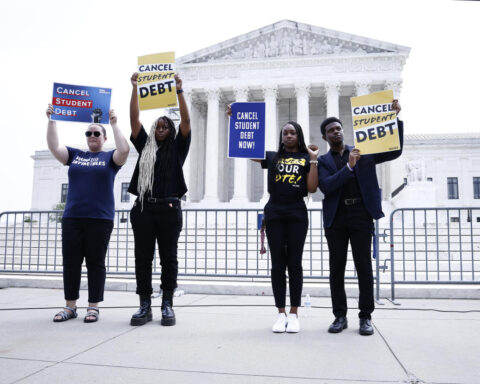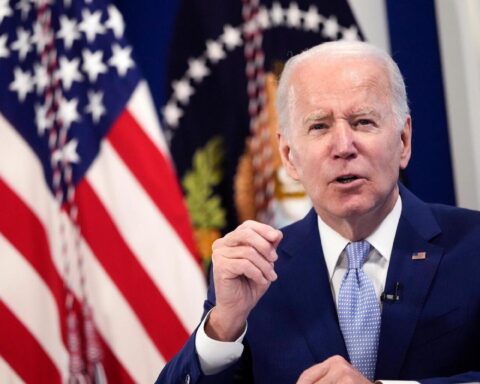Washington is staring down a bumpy road to infrastructure consensus.
The Biden administration’s roughly $2 trillion proposal focused on infrastructure and the climate crisis enters a critical week on Capitol Hill as congressional Republicans wrestle with what a scaled-down counter offer might look like.
Complicating the already winding path to bipartisan agreement has been pressure to act on gun violence and police reform, amid the ongoing coronavirus pandemic, all of which threaten to put infrastructure on the back burner.
But the White House has continued its overtures to host GOP lawmakers in the Oval Office in an effort to forge meaningful, unified progress — even as Republicans remain skeptical.
Here’s where things stand on Capitol Hill:
Outreach overdrive
Biden is set on Monday to host his second bipartisan gathering in as many weeks in the Oval Office as White House officials continue to map out the path forward for the President’s top legislative agenda item.
White House chief of staff Ron Klain will host leaders of the moderate House Democratic Blue Dog Coalition on Tuesday and key members of the New Democrat Coalition on Wednesday, according to a White House official.
Klain will be joined by Steve Ricchetti, counselor to Biden and one of the President’s closest advisers, and Louisa Terrell, Biden’s legislative affairs chief, the official said.
For the last three weeks, Cabinet officials and senior White House aides have fanned out in a full-scale part-listening and part-sales-pitch tour on Capitol Hill, according to administration officials, with phone calls and meetings across both chambers and parties and with top staffers of key leadership and committee offices.
Biden’s legislative affairs team had made 139 calls to members and top staffers as of last week, with Cabinet secretaries holding 27 calls directly to members, including seven Republicans. Biden’s policy teams have held 26 staff briefings, including nine at the member level, including one for GOP leadership, officials said.
Administration officials are working on multiple fronts to gauge what pathways might exist with Republicans, and perhaps more crucially, where Democrats are on their policy preferences given the exceedingly narrow majorities in the House and Senate.
Klain in particular has been working through the various power centers of the House Democratic Caucus over the course of the last month. He met with leaders of the Congressional Progressive Caucus on March 17 and on March 23 with top progressives including New York Reps. Alexandria Ocasio-Cortez and Jamaal Bowman, officials said.
Klain and Ricchetti also hosted members of the moderate, bipartisan House Problem Solvers Caucus last week.
Room for a bipartisan $800 billion deal?
As GOP Sen. Lisa Murkowski of Alaska said last week: “We must present an alternative. If we think this is too big, how would we pare it down, how would we define it? How would we pay for it?”
The first glimpse of that came Sunday when Republican Sen. John Cornyn of Texas and Democratic Sen. Chris Coons of Delaware appeared alongside each other on Fox News to discuss a proposal that would spin off the infrastructure-heavy portion of Biden’s plan into a separate $800 billion package that might find bipartisan support.
The other parts of Biden’s plan could then potentially pass with just Democratic support through budget reconciliation.
Asked what’s in the proposal for Republicans, Coons responded, “The broader question you’re really asking is what is in it for our country and what’s in it for the people we represent from our state if Republicans and Democrats work together to solve problems.”
“I think that if we come together in a bipartisan way to pass that $800 billion hard infrastructure bill that you’ve been talking about, that I’ve been urging, then we show our people that we can solve their problems. We’ve all agreed for a long time that we need to invest more in American infrastructure,” Coons said.
Cornyn said Coons was “half right,” assessing that there is a “core infrastructure bill that we could pass with appropriate pay-fors like roads and bridges — even reaching out to broadband, which this pandemic has exposed a great digital divide in the country.”
“We have seen advances in telemedicine. We have seen more people learning online. I think we could all agree to that. But I think that’s the part we can agree on, so let’s do it and leave the rest for another day and another fight.”
That other fight would center on the second prong of the White House’s legislative package, known as the American Families Plan.
The proposal will focus heavily on what administration officials call “social infrastructure” — things like universal pre-K, free community college, paid leave and health care. The plan is likely to be unveiled shortly before Biden’s scheduled April 28 joint session address to Congress, officials say.
Sen. Shelley Moore Capito of West Virginia, the top Republican on the Senate Environment and Public Works Committee, had suggested during an interview on CNBC last week that a “sweet spot” for a bipartisan deal could come in at $600 billion to $800 billion.
But in a sign that Republicans haven’t reached their own consensus yet, Sen. Mitt Romney of Utah told reporters that he thinks the potential $800 billion top-line idea “seems a little high.”
Still, no comprehensive GOP plan has been released so far — leaving most Republicans, for the time being, focusing their energy on marketing Biden’s proposal as simply too large.
Capito has previously called the President “very sincere” in his discussions about infrastructure, but expressed concern about getting “rolled” in the end “because there is a partisan process.”
“You saw that happen under Covid, and I am concerned about it,” she said.
But Biden has signaled openness to negotiations, and made clear to Republicans in a private Oval Office meeting this month that he wanted their proposals and would have his legislative and policy teams follow up from the White House side of things, according to people in the meeting.
The President and his top advisers, however, have also made clear that the scale of the package they put on the table is one that meets their view of what’s necessary for an economy ravaged by the pandemic and facing decades of what they see as underinvestment in key sectors.
Democrats split on state and local tax deduction fight
While some in the Democratic Party try to leverage a full repeal of the cap on state and local tax deductions as part of the infrastructure package negotiations, Ocasio-Cortez made clear this is not a move she is on board with.
“Frankly, I disagree with that. I don’t think we should be holding the infrastructure package hostage for a 100% repeal of SALT, especially in the case of a full repeal. Personally, I can’t stress how much that I believe that is a giveaway to the rich,” the New York Democrat said Friday.
“I think we can have a conversation about the policy, but it’s a bit of an extreme position, to be frank.”
The rift is just the latest flashpoint underscoring how many issues can pop up during negotiations over a proposal of this size. “Tip of the iceberg,” one House Democrat, asked about the SALT cap, told CNN last month of the number of looming issues likely to arise in the weeks ahead.
Ocasio-Cortez was one of only two New York Democrats to not sign onto a letter sent to House Speaker Nancy Pelosi and Majority Leader Steny Hoyer outlining their desire to repeal the cap on the state and local tax deduction.
On Thursday, Problem Solvers Caucus co-chair Democratic Rep. Josh Gottheimer, a New Jersey Democrat, and New York Rep. Tom Suozzi, a New York Democrat, announced a bipartisan caucus dedicated to a full repeal of the cap, which so far has more than 30 members, though not all are supportive of holding up Biden’s infrastructure package to get the repeal of the tax measure.
The clock is ticking
Pelosi has said she wants a bill to pass the House by July 4th, now just 11 weeks away with a few Capitol Hill recesses in between.
Additionally, the House Transportation and Infrastructure Committee plans to move on a surface transportation bill by the end of May, but several other House committees plan to take action as well on other aspects of the sprawling proposal.
Transportation Secretary Pete Buttigieg told CNN’s Jake Tapper on “State of the Union” earlier this month, “The President wants to see major action in Congress and real progress by Memorial Day.”
“You know, we’ve got some real kind of shot clocks on this in terms of things that have to get reauthorized by the end of September. So, you know, the sooner the better I think is the bottom line. We’ve got to get this done,” he added.
What’s in the plan again?
Keep in mind, the plodding negotiations playing out on Capitol Hill are to be expected for a proposal this enormous.
Biden’s infrastructure plan is big, and addresses a lot more than just roads and bridges. A few of the toplines:
Transportation: $621 billion. Unsurprisingly, funding improvements to roads, bridges, railways and other infrastructure has been a central piece of Biden’s recovery plans. He has said that it will create “really good-paying jobs” and help the nation compete better.
Home care services and workforce: $400 billion. The plan would expand access to long-term care services under Medicaid, eliminating the wait list for hundreds of thousands of people.
Manufacturing: $300 billion. Some of the funds would be carved out for manufacturers that focus on clean energy, rural communities, and programs that give small businesses access to credit.
Housing: $213 billion. Biden is calling on Congress to build, renovate and retrofit more than a million affordable and energy efficient housing units. The plan would also build and rehabilitate more than 500,000 homes for low- and middle-income homebuyers.
“It’s the largest American jobs investment since World War II. It’ll create millions of jobs, good paying jobs, it’ll grow the economy, make us more competitive around the world, promote our national security interests and put us in a position to win the global competition with China in the upcoming years,” the President said as he unveiled the proposal last month.
“It’s big, yes. It’s bold, yes. And we can get it done.”





